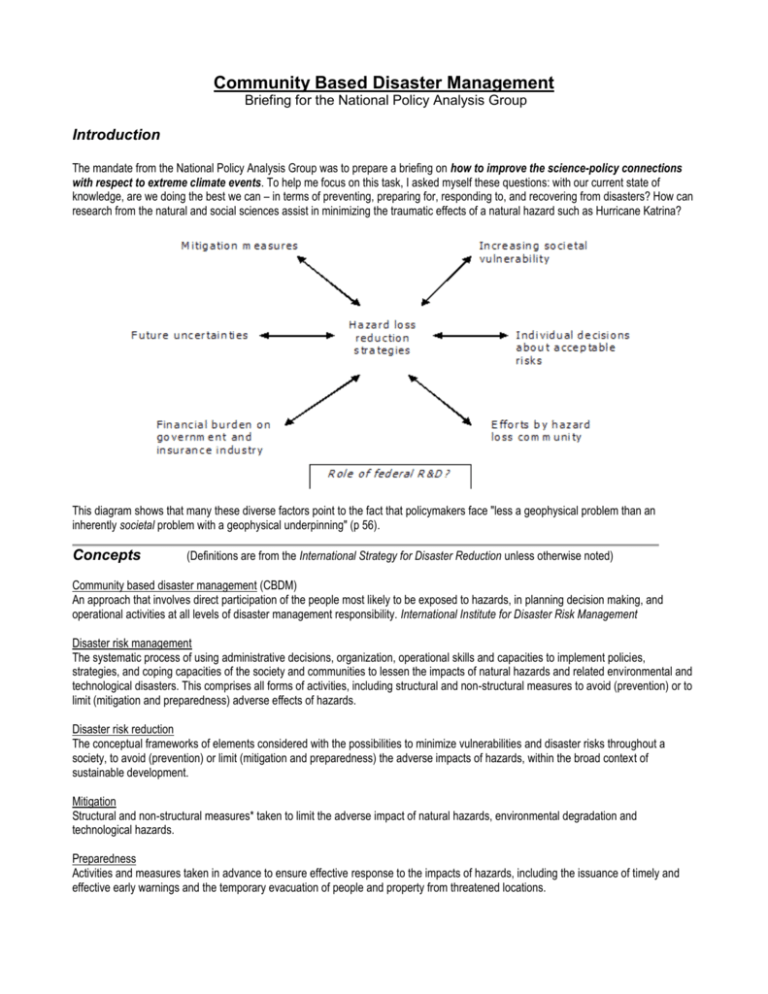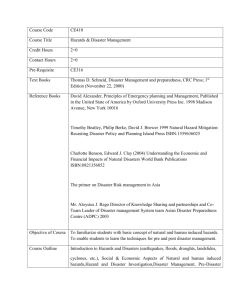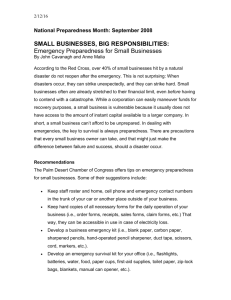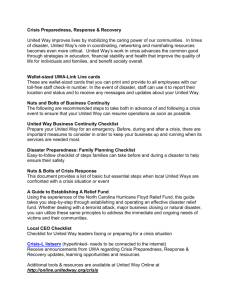Community Based Disaster Management
advertisement

Community Based Disaster Management Briefing for the National Policy Analysis Group Introduction The mandate from the National Policy Analysis Group was to prepare a briefing on how to improve the science-policy connections with respect to extreme climate events. To help me focus on this task, I asked myself these questions: with our current state of knowledge, are we doing the best we can – in terms of preventing, preparing for, responding to, and recovering from disasters? How can research from the natural and social sciences assist in minimizing the traumatic effects of a natural hazard such as Hurricane Katrina? This diagram shows that many these diverse factors point to the fact that policymakers face "less a geophysical problem than an inherently societal problem with a geophysical underpinning" (p 56). Concepts (Definitions are from the International Strategy for Disaster Reduction unless otherwise noted) Community based disaster management (CBDM) An approach that involves direct participation of the people most likely to be exposed to hazards, in planning decision making, and operational activities at all levels of disaster management responsibility. International Institute for Disaster Risk Management Disaster risk management The systematic process of using administrative decisions, organization, operational skills and capacities to implement policies, strategies, and coping capacities of the society and communities to lessen the impacts of natural hazards and related environmental and technological disasters. This comprises all forms of activities, including structural and non-structural measures to avoid (prevention) or to limit (mitigation and preparedness) adverse effects of hazards. Disaster risk reduction The conceptual frameworks of elements considered with the possibilities to minimize vulnerabilities and disaster risks throughout a society, to avoid (prevention) or limit (mitigation and preparedness) the adverse impacts of hazards, within the broad context of sustainable development. Mitigation Structural and non-structural measures* taken to limit the adverse impact of natural hazards, environmental degradation and technological hazards. Preparedness Activities and measures taken in advance to ensure effective response to the impacts of hazards, including the issuance of timely and effective early warnings and the temporary evacuation of people and property from threatened locations. Risk The probability of harmful consequences, or expected losses (deaths, injuries, property, livelihoods, economic activity disrupted or environment damaged) resulting from interactions between natural or human-induced hazards and vulnerable conditions. Beyond expressing a possibility of physical harm, it is crucial to recognize that risks are inherent or can be created or exit within social systems. It is important to consider the social contexts in which risks occur and that people therefore do not necessarily share the same perceptions of risks and their causes. Vulnerability The conditions determined by physical, social, economic, and environmental factors or processes, which increase the susceptibility of a community to the impact of hazards. Case Studies Cuban model Project Impact Preparedness The National Civil Defense is a combination of national structure and grassroots organization. It builds upon the municipal and administrative structures already in place. In practice, the head of the Civil Defense in any given province or municipality is someone closely familiar with how government works in that province. Local groups are taking orders from someone familiar to them, not a stranger brought in for the duration of the emergency. There is a clear and effective communication system in place with alternative systems of communication place if the power lines are disrupted by the hazard. There are three community-level exercises in which a significant number of the population participates: community risk-mapping, annual updating of the emergency plan, and a national simulation exercise. The rough equivalent to the notion of 'preparedness' is the risk and vulnerability assessment activities carried out by the communities in Project Impact. These activities included identifying hazards associated with critical facilities; determining the vulnerability of public infrastructure, populations, or businesses; or assessed risks to transportation or utility systems. Listed examples include: develop watershed study and restoration project; identify single family homes for retrofitting; create a community-wide local mitigation strategy; conduct a generator capability assessment; set up a GIS mapping system; build an inventory of at-risk structures and hazardous buildings. It was noted in the Report that few communities included a socio-economic analysis as part of their risk and vulnerability assessment projects. Mitigation At the national level, Cuba has put a number of national institutions and mechanisms in place for disaster mitigation, including a legal framework that mandate requiring all adult citizens to receive civil defense training; physical planning and land use regulations embedded in government structures; measures in place to prevent overpopulation of high risk areas. At the community level, development of a "culture of safety" through education and reinforcement of human capital. Accept, screen, and approve loan/grant applications. Elevation, relocation, and retrofit projects. Creation of a tool-lending library. Acquire flood-damaged structures and established buy-out programs. Replacement of non-flexible gas lines/installation of automatic gas shut-off valve. Strengthen or establish land use regulations and building codes. Develop criteria for inspections on retrofitted homes. Regionalize home retrofit program. Arguments Both of the models selected as representative of the CBDM approach are not without some limitations and/or deficits. This section will outline a few of the "sticking points" and counter-sticking points derived from my reading, but it is obviously not meant to be exhaustive. The Cuban model A significant number of criticisms of the Cuban model have been made by Cuban-born B. E. Aguirre of the Disaster Research Center at the University of Delaware (Aguirre, 2002). While acknowledging that the disaster preparedness program in Cuba is effective in certain areas, he maintains that it is built upon the extensive system of social controls in the country. Specific points in his critique are: Post-disaster tasks such as the removal of debris, restoration of lifeline services and other essentials are accomplished through the activation of people who are "pressed into service" or who volunteer (p.5) While reconstruction efforts are usually quite effective in the cases of hospitals, schools, and critical facilities, housing reconstruction is very deficient and most disaster victims are "left to their own devices and the sporadic assistance from international humanitarian programs" (p. 5). The number of disaster mitigation programs to mitigate the effects of hazards is paltry and there is a "near absence in the record of comprehensive land use planning, zoning, and building codes as mechanisms" (p.6). Referring to the positive picture painted by the Thompson report, Mr. Aguirre notes that in particular, the statement 'the political commitment on the part of the government to safeguard human lives' is a "rhetorical statement...that is easily disproved and that in the absence of empirical evidence and conceptual clarity do[es] not help elucidate the state of mitigation in Cuba" (p. 9). He does note, however, that although the Cuban state has a "very poor record" in the areas of disaster reconstruction, recovery, and mitigation, its record in disaster preparedness and response is much better (p. 7). The Thompson report countered the claim that Cuba's model of risk reduction should be dismissed because of its dependence on a strong centralized government by stating that the model's success deserves credit especially because of "its focus on community mobilization around preparedness" (Thompson, p.8). The report also notes that: The political will so lacking [in other countries] in the national arena often exists at the local level. "The combination of training, outside technical expertise, and local government structures can provide a structure for disaster work, decision-making, prioritization, and inter-sectoral coordination" (p. 46) The International Federation of Red Cross and Red Crescent Societies (IFRC), in their 2002 World Disaster Report, also stated: "Cuba’s success in saving lives gives us a model of effective government-driven disaster preparedness – what was the secret of its success? Geographer Ben Wisner suggests “one cannot ‘fix’ disaster risk with technology alone. It is also a matter of enacting and enforcing laws, building and maintaining institutions that are accountable, and producing an environment of mutual respect and trust between government and the population” (Report, Chapter 1 summary). Project Impact By most accounts, Project Impact was a successful initiative, which is why it is so troubling that the program was axed. The only way I initially became aware of Project Impact was through searches on FEMA's web site - in which it was alluded to in the News Releases section; however there is no longer any information on the project on the FEMA web site itself. Fortunately, the involvement with Project Impact by the Disaster Research Center at the University of Delaware has allowed access to a number of reports conducted by the Center, some of which have been used here. The following are comments drawn from the "Challenges associated with Project Impact" sections of the final report: Some [communities] pointed to problematic bureaucratic requirements, conflicts between FEMA and state emergency agencies, and pressures from FEMA to spend money before they were ready to (Year 3 Pilot Communities Report, p. 66). Changes in partnerships [a key component of the program] necessitated repeated recruitment efforts, including turnover in the Project Impact Coordinator role (p. 67). The fact that key potential partners were also engaged in fighting against disaster-resistant or building regulations (p. 68). Participants in Project Impact struggled to keep their elected officials focused on disaster mitigation (p.68). The balance between under-using and over-using partners is one that [the] communities struggled to find (p.69). Finding long-term funding sources was becoming a more pressing challenge for the pilot communities as the months went by (p.70). The Seattle Project Impact is an example of a project that not only was a success during the years of the FEMA involvement, but was consequently institutionalized by the City of Seattle. Detailed information is provided at the web site . Research This section presents suggested topics for further research in disaster studies, culled from the articles and reports that I consulted. The topics all potentially address the mandate of the National Policy Analysis Group which was to improve science-policy connections with respect to extreme climate events. Studies on the how to measure the reduction in losses that result from disaster preparedness and mitigation measures and programs. Studies that assess the relative importance of different risk reduction activities. Studies that advance the use and efficacy of vulnerability analysis. Development of methods for large-scale interdisciplinary analysis of disaster interventions. Studies that illuminate the connection between politics and disaster preparedness. Studies to examine the issues around community vulnerability mapping. Social science disaster research already has a 50 year track record (Quarantelli, 2002, Rodriguez, 2004). This lively community of scholars has produced a body of work that can be mined at any time in order to inform policy. Some highlights and directions for further research are noted below: The need to integrate the study of minorities, women and youth into disaster research. The need to generate research findings that are relevant, useful, and understandable to the practitioners in the disaster field (who are often too busy to be reading academic journals). The need for more in-depth, cross-cultural and transnational studies focusing on hazards, risks, and crisis which contribute to or are embedded in disasters. The need for more theoretical approaches such as wedding the symbolic-interaction perspective with the critical, political-economic perspective to disasters. Researchers and practitioners using the community based disaster management approach regularly meet, hold conferences, publish proceedings and reports, and generate directions for research from within their community. One such example is: The Sustainable Environment and Ecological Development Society (SEEDS), FES (a German development foundation), and UNCRD Hyogo Office jointly organized a workshop called ‘ACTAHEAD’ on 2-4 December 2002, in India. The purpose of the workshop was to discuss CBDM issues from an integrated policy perspective, and recommend possible future directions of CBDM focusing on sustainability. The workshop raised questions such as: Does CBDM really work? Is CBDM a panacea to the problems of social, economic and physical vulnerability? Is the successful experience really transferable or replicable? Or is it very context-specific? In a context where government (however effective or ineffective) is still the eminent domain, how do the community-based approaches link with the local governance issues? Will CBDM always be “managed” by outsiders? How do we replicate/ upscale the success stories? Do we need to build a community of CBDM practitioners? If yes then how and towards what end What are the accountability issues? Are the CBDM projects accountable to the regional structures (downstream impacts)? Can the CBDM encourage communities to demand greater accountability from their local, provincial and central governments? Briefing web site with full bibliography and additional information available at http://library.riohondo.edu/PBLBriefing.htm PPOL 749 – Science, Technology & Public Policy University of Massachusetts Boston Fall 2005 Jan Coe, Presenter









